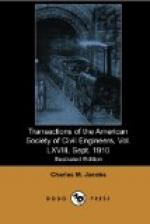This Division commences at the west side of Bergen Hill and passes through the hill in two single-track rock tunnels to a large permanent shaft at Weehawken, near the west shore of the North River, and thence eastward a distance of 224 ft. to the Weehawken shield-chamber. It then passes under the river through two cast-iron, concrete-lined, single-track tunnels, with outside diameters of 23 ft., to a point under 32d Street, near Eleventh Avenue, in New York City, and thence through two single-track tunnels of varying cross-section, partly constructed in cut-and-cover, to the east side of Tenth Avenue. It then passes into the Station Yard and terminates at the east building line of Ninth Avenue. The work included the Station Yard excavation and walls from Tenth Avenue to Ninth Avenue, and the retaining walls and temporary underpinning of Ninth Avenue. The aggregate length of the line in this Division is 2.76 miles.
New York Station and Approaches.—Mr. George Gibbs, Chief Engineer of Electric Traction and Station Construction.
The Station and its approaches extend from the east line of Tenth Avenue eastward to points in 32d Street and 33d Street, respectively, 292 ft. and 502 ft. east of the west line of Seventh Avenue. This Division included the construction of subways and bridges for the support of 31st and 33d Streets and Seventh, Eighth, and Ninth Avenues, the Station building between Seventh and Eighth Avenues, the foundations for the post office to be erected west of Eighth Avenue, the service power-house in 31st Street between Seventh and Eighth Avenues, the power-house in Long Island City, the traction system, tracks, signals, and miscellaneous facilities required in the physical construction of the entire terminal railroad ready for operation. Messrs. McKim, Mead, and White were the architects for the Station and Messrs. Westinghouse, Church, Kerr and Company executed the structural engineering work, both in the station and for the support of the streets, as well as the construction of the subways.
The station is of steel skeleton construction with masonry curtain walls, all supported by a system of columns extending to a rock foundation. This building covers two city blocks and one intersecting street, and has an area of about 8 acres. It is 774 ft. long, 433 ft. wide, with an average height above the street of 69 ft., and a maximum of 153 ft. The main waiting-room is 277 ft. long, 103 ft. wide and 150 ft. high. The Concourse is 340 ft. long and 210 ft. wide.
The level of the track system below the street surface varies from 39 to 58 ft., and is from 7 to 10 ft. below mean high water in the harbor, thereby necessitating the establishment of an elaborate system of drainage over the entire station yard area. Access to the street is gained by elevators and stairways.
To accelerate the loading and unloading of the trains, high platforms will be constructed in the station on a level with the floors of the cars, in order to avoid the use of car steps and increase the traffic capacity of the station.




